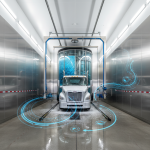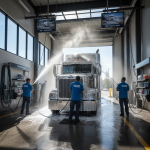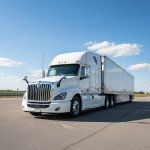Keeping your fleet of trucks clean and presentable is essential for any business that relies on transportation. But with so many options available, choosing the right method to wash your trucks can be overwhelming. Two popular options are brushes and touchless truck wash systems. Both have their pros and cons, and the debate over which is better is ongoing. Some argue that brushes provide a more thorough clean, while others swear by the gentler touchless approach. As a digital marketing expert, it’s my job to help you make an informed decision. In this article, we’ll explore the differences between brushes and touchless truck wash systems and help you decide which one is right for your business. Get ready for the ultimate showdown!
Pros and cons of brush truck washing
Brush truck washing is a traditional method that has been around for decades. It involves using a brush or a set of brushes to scrub the truck’s surface and remove dirt and grime. While there are many benefits to this method, there are also some drawbacks to consider.
### Pros
One of the biggest advantages of brush truck washing is the thoroughness of the clean. Brushes can reach every nook and cranny, ensuring that every part of the truck is cleaned properly. This is especially important for trucks that are used in industries like construction or agriculture, where they are exposed to a lot of dirt and debris.
Another benefit of brush truck washing is the speed. Because the brushes are doing the work, the cleaning process is usually faster than other methods. This is particularly important for businesses that have a large fleet of trucks that need to be cleaned regularly.
Finally, brush truck washing is often less expensive than other methods. This is because the equipment required is relatively simple and doesn’t require a lot of maintenance.
### Cons
While there are many benefits to brush truck washing, there are also some drawbacks to consider. One of the biggest concerns is the potential for damage to the truck’s surface. Brushes can be harsh on the paint and can cause scratches or other damage if not used properly.
Another concern is the potential for the brushes to spread dirt and debris around, rather than removing it. This can be especially problematic if the brushes are not cleaned regularly, as they can become clogged with dirt and debris.
Finally, there is the environmental impact to consider. Brush truck washing uses a lot of water, and the chemicals used in the cleaning process can be harmful to the environment if not disposed of properly.
Pros and cons of touchless truck washing
Touchless truck washing is a newer method that has become increasingly popular in recent years. As the name suggests, this method does not involve any brushes or physical contact with the truck’s surface. Instead, high-pressure water and specialized cleaning solutions are used to remove dirt and grime. Like brush truck washing, there are pros and cons to consider.
### Pros
One of the biggest advantages of touchless truck washing is the gentle approach. Because there is no physical contact with the truck’s surface, there is less risk of damage to the paint or other parts of the truck. This is especially important for businesses that have newer or high-end trucks that they want to keep looking like new.
Another benefit of touchless truck washing is the reduced environmental impact. Because this method uses less water and fewer chemicals, it is generally considered to be more environmentally friendly than brush truck washing. This can be an important consideration for businesses that want to reduce their carbon footprint.
Finally, touchless truck washing is often more convenient than other methods. Because there are no brushes involved, there is less equipment to maintain, and the cleaning process can often be completed more quickly.
### Cons
Despite the many benefits of touchless truck washing, there are also some drawbacks to consider. One of the biggest concerns is the potential for missed spots. Because there is no physical contact with the truck’s surface, it can be difficult to ensure that every part of the truck is cleaned properly. This can be especially problematic for trucks that are used in industries like construction or agriculture, where they are exposed to a lot of dirt and debris.
Another concern is the cost. Touchless truck washing equipment can be more expensive than brush truck washing equipment, and the cleaning solutions can also be more expensive. This can be a significant consideration for businesses that are looking to keep their costs down.
Finally, there is the potential for damage to the truck’s surface if the high-pressure water is not used properly. This can be especially problematic for older or more delicate trucks that are more prone to damage.
Environmental impact of each method
When it comes to the environmental impact of truck washing, there are pros and cons to both brush and touchless methods. Brush truck washing uses a lot of water and can be harmful to the environment if the chemicals used in the cleaning process are not disposed of properly. Touchless truck washing, on the other hand, uses less water and fewer chemicals, making it generally considered to be more environmentally friendly.
However, it’s important to note that touchless truck washing still uses water and chemicals, and these can still have a negative impact on the environment if not handled properly. Additionally, the high-pressure water used in touchless truck washing can cause erosion and other damage to the surrounding area if not used properly.
Cost comparison between brush and touchless truck washing
When it comes to the cost of truck washing, there are many factors to consider. While brush truck washing equipment is generally less expensive than touchless equipment, the cost of the cleaning solutions and the maintenance required can add up over time. Touchless equipment, on the other hand, can be more expensive up front, but the reduced water and chemical usage can lead to cost savings over time.
Ultimately, the cost comparison will depend on a variety of factors, including the size of your fleet, the frequency of washing, and the type of trucks you have.
Considerations for choosing the right truck washing method for your fleet
When it comes to choosing the right truck washing method for your fleet, there are several factors to consider. These include:
– The type of trucks you have
– The frequency of washing
– The location of your trucks and the availability of washing facilities
– The environmental impact
– The cost
It’s important to weigh all of these factors before making a decision. Consider talking to other businesses in your industry to see what methods they use and what has worked for them.
Maintenance and upkeep for each method
Both brush and touchless truck washing require maintenance and upkeep to ensure that they are operating properly. Brush equipment needs to be cleaned regularly to prevent buildup of dirt and debris, and the brushes themselves need to be replaced periodically. Touchless equipment also needs to be maintained, and the high-pressure water nozzles need to be checked to ensure that they are functioning properly.
Customer satisfaction and impact on business reputation
Keeping your trucks clean and presentable is not just about practical considerations like maintenance and cost. It’s also about customer satisfaction and your business’s reputation. A clean and well-maintained fleet can help to build trust with customers and can make a positive impression on potential clients.
Case studies: companies that have switched from brush to touchless truck washing
There are many companies that have switched from brush truck washing to touchless truck washing in recent years. These companies have cited a variety of reasons for making the switch, including concerns about damage to the trucks, the environmental impact, and the cost.
For example, one construction company in California made the switch to touchless truck washing after experiencing frequent damage to their trucks from the brushes. Another company in the transportation industry switched to touchless washing to reduce their water usage and environmental impact.
Conclusion: which method is the ultimate winner?
When it comes to choosing between brush and touchless truck washing, there is no clear winner. Both methods have their pros and cons, and the best choice will depend on the specific needs of your business. Consider factors like the type of trucks you have, the frequency of washing, the environmental impact, and the cost when making your decision. Ultimately, the key is to choose a method that will keep your fleet clean and presentable while also meeting your business’s practical and financial needs.




